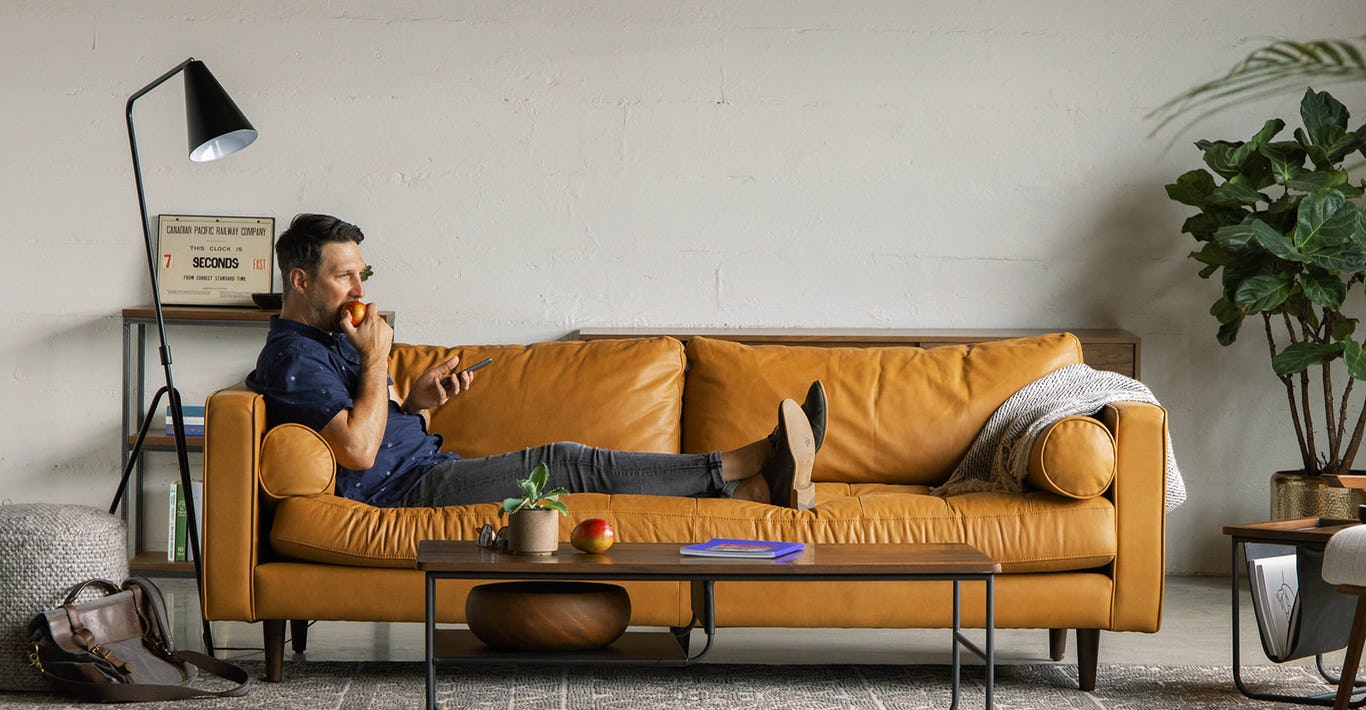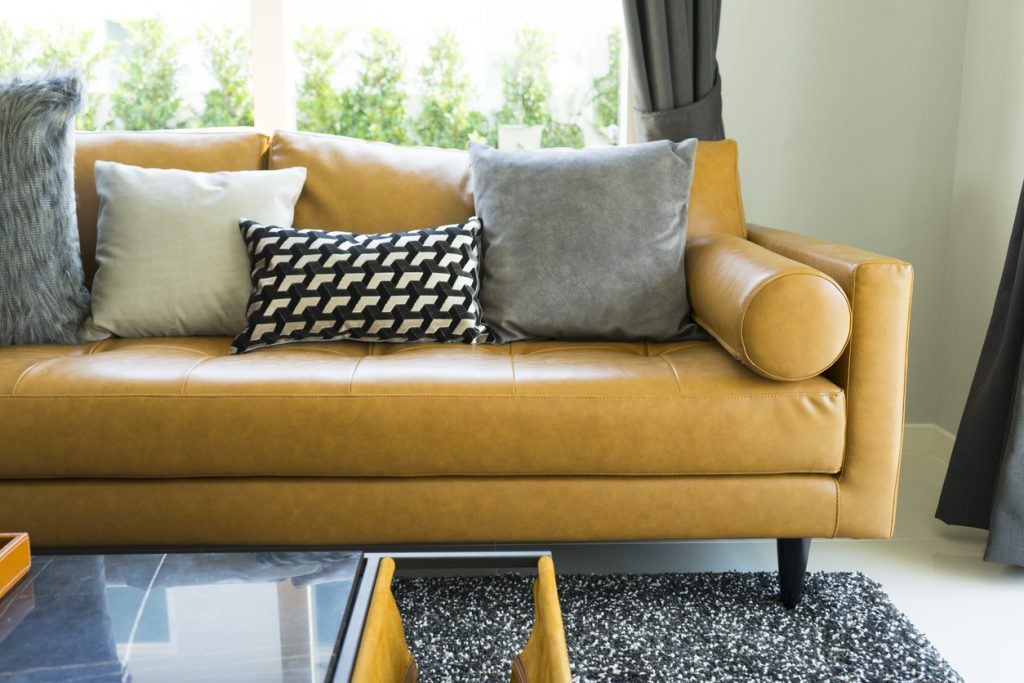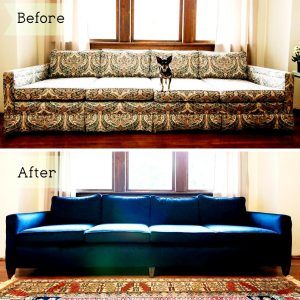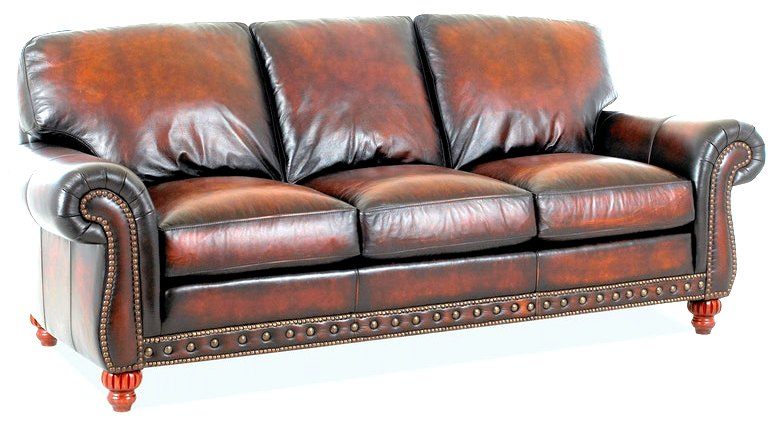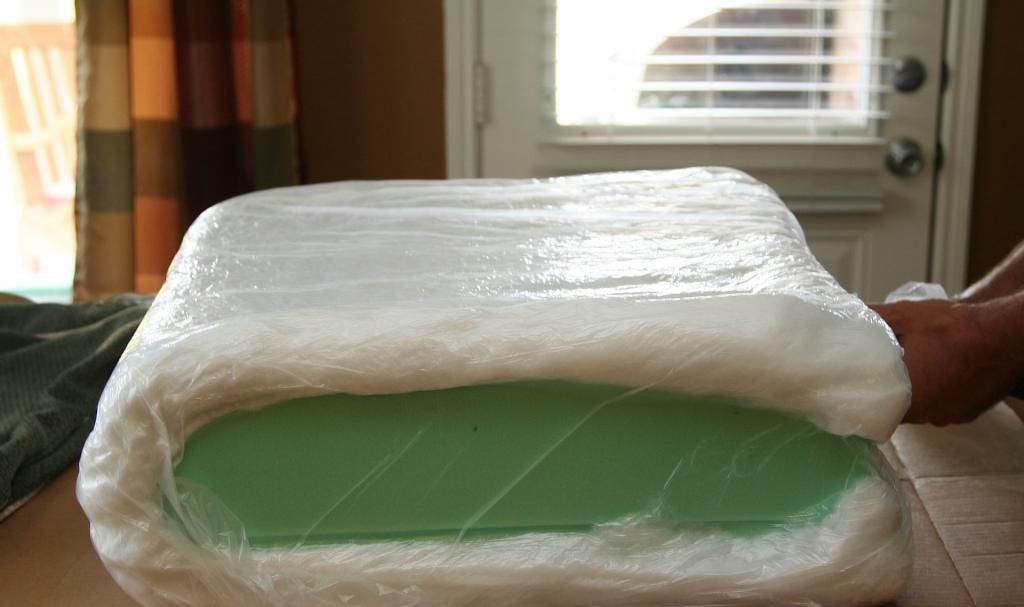Some companies such as Ikea, renowned for its ergonomic support and quality, sustainable materials, as well as space-saving designs.
But many people who buy their products for these reasons complain that their sofas and futons are too firm and uncomfortable.
The tips below are easy and effective and will make your sofa most comfortable, whether you have a new or an old one. You’ll find out how to soften the upholstery, the foam, and the cushions. You’ll also learn how to recognize and fix structural problems that affect your couch’s flexibility and ultimate comfort.
Read along!
How Can I Soften My Couch?
Shaping the foam is the first uncomfortable couch fix. This job takes just a few minutes to complete following the steps below:
- Use a blow dryer to heat it. Use the lowest setting on your blow dryer. Move the dryer constantly on the whole surface of the couch instead of keeping it in one spot. Keep the dryer about 9 inches away from your new sofa.
- Squeeze it. Use your hands to squeeze the foam before Google-ing “Ikea sofa too firm.” Be firm and fast so that your hands produce enough heat to restore your foam’s flexibility. This technique takes just a few seconds, but the divan foam won’t stay fluffed for long.
- Use water. Don’t pour too much water on your foam. Just a few tablespoons are enough for the foam to regain elasticity. After that, use your hands to reshape the foam. Once the water dries, the foam will take the shape you needed. If you’re not satisfied with the result, try again.
Other techniques to making your couch softer relate to the leather upholstery and stiff ottoman pillows, as well as proper maintenance and the needed height. Read more about those below.
SUMMARY: You can soften your ottoman by using radiating heat and water to mold it into shape.
7 Tips on How To Make Your Couch More Comfortable
Sometimes, your couch needs comfy pillows, blankets, or a mattress topper. Other times, you need to explore underneath it for hidden treasures or retighten the screws. Read the tips below to make sure your ottoman feels as comfortable as possible.
1. Get Rid of Hidden Things in Your Couch
The junk or dirt that falls underneath your ottoman or between the cushions causes an unpleasant sitting experience. Even if your sofa is new, you can still take out the cushions or disassemble it to search for tiny pieces of plastic or cardboard.
If you’ve had the sofa for some time, you might find that the missing toys or lost change cause this discomfort.
2. Ensure the Legs are Properly Screwed and Balance
If you’re looking for uncomfortable sofa solutions for a wobbly sofa, retightening the screws should fix it.
Incorrect balance of the legs affects sofa comfort because loose screws can’t support your weight properly.
Look at the sofa’s legs by turning it upside down to make sure everything is ok. The legs should fit snuggly in the holes. If they don’t, drill in the loose legs and tighten the screws.
3. Choose Some Comfortable Throw Pillows
Reduce the number of pillows on your divan to make sure it’s not cluttered by using throw pillows. Too many pillows on your sofa reduce sitting space and make your ottoman feel extremely uncomfortable.
- Choose firm if you need good support to alleviate back pain or to correct your posture.
- Choose softer pillows if you want a floating-like sitting experience. Google “Ikea couch uncomfortable,” and you’ll get softer pillows as a first idea.
- Make sure their colors fit your living room style (dining room) and décor.
4. Re-Upholstery the Couch
Restore your couch’s flexibility by reupholstering it. Old upholstery looks bad, but it’s also saggy and can’t support your body weight so that sitting on the sofa feels very uncomfortable.
Although you need a significant budget for the job, new upholstery is more stylish.
If you have limited funds, sometimes even a quick sew job for the upholstery or gluing a broken frame can fix things.
5. Increase Comfort With Increase in Height
- You need a higher divan if:
- You’re mobility challenged
- You need to use a laptop on a table in front of you
- You have to strain upwards to get to your coffee table
Don’t worry if your ottoman has small legs or dimensions. You can:
- Order new legs from the sofa’s manufacturer together with the correct screws.
- Add casters to secure your sofa and make it higher.
6. Don’t Ignore Throw Blankets!
Throw blankets improve divan comfort and are perfect for reading or watching TV.
These blankets look stylish and modern, plus they cover you in a cocoon of protection when you’re enjoying a cup of hot cocoa on a cold day.
Throw blanket is my number one tip for sleeping on the sofa like you would on your own sofa bed.
7. Keep It Clean
Cleanliness has a psychological dimension that helps you relax. There’s also physical comfort because dried stains are harder and push into your skin. You might also strain uncomfortably to avoid rips or spills.
The first step to cleaning your ottoman is reading the instruction manual. Avoid detergents, especially if your sofa has a sensitive fabric. It’s best to use only water or call a professional cleaning company.
SUMMARY: Ensure that your ottoman has clean upholstery and no hidden objects underneath its pillows. Check that the legs are secure and the right size. Use throw pillows and throw blankets to make your couch cozier.
Do Leather Couches Get More Comfortable?
No. Leather sofas become harder with time, plus they’re stiffer than fabric upholstery from the get-go. You can solve this issue by following the tips below:
- Pour Vaseline on a soft cloth and rub it into the sofa. Focus on each section. Don’t apply too much Vaseline; make sure your sofa has absorbed all the Vaseline before adding some more.
- Wipe the couch. Ensure there’s no more grease on your sofa, and that the leather upholstery has regained smoothness.
Pro tip: Instead of Vaseline, you can use shaving cream, mink oil, glycerin, or milk balm. Repeat the steps above. These steps also work for futons.
Pro tip: If you get a store-bought leather softener, check with the sofa manufacturer to ensure it won’t damage the leather.
SUMMARY: While leather couches don’t get more comfortable over time, you can rub Vaseline or oil-based products into their upholstery to solve this issue.
About Couch Topper
Isn’t that another word for a sofa? Well, yes and no. I mean, yes, technically it’s a sofa topper, and it’s something to cover that little 2×4 slab on the sofa that helps give the sofa an upholstered look. But, since it is for the divan, not a sofa, it’s not “something to cover”. It’s to make it look more like a sofa. Since we got rid of the brown upholstered sofa in favor of this whitish-colored living room one (note the right arm just has a thin cream-colored fabric, the rest is solid black) we were stuck with that little “sock” on the left arm. A true sofa topper for a standard sofa would cover that up. Since this one is a little more extended, it’s not going to look the same in the living room. And it wouldn’t work for this design. So we are buying a gray leather sofa cover. It should look like we are almost trying to make it look like a real sofa. I think I am going to hang the cushion for it on the wall, maybe make the base of the divan (that has those diagonal short legs) be a little lower and the ottoman top higher to make it look more like a couch.
That would look much better than those rather short legs. It just has this weird slope, but it’s hard to see that in this picture. This is the divan I have been working on. I’ve got the cushion attached and it has been taking some getting used to. I kind of like the arm bolsters, but the cushion itself doesn’t seem very cushy. I think I need to add more filler to the cushion.
How Can I Make My Couch Cushions Softer?
Thin plastic cushions can bounce around when the couch or loveseat is in motion, which makes them uncomfortable to sit or lay on. In fact, they can make your couch and loveseat seem even cozier if the cushions are full, but that’s not necessarily the case if you’ve got a thin cushion. “If you have thick cushions, it’ll be that much plusher to sit or lay on,” Sweeney says. But for those of you in the market for new pillows, soft plastic cushions aren’t the best bet. Cushions: How thick are they?
Foam: If the foam or memory foam feels wispy, then it’s time for a new pillow, Sweeney says. Plastic memory foam is better because it feels more substantial, she adds. Elastic memory foam: Like its soft counterpart, a thin, elastic memory foam pillow is probably only suited for short naps. It won’t absorb heat as well as other materials, and won’t provide you with the comfortable lumbar support you may desire.
How to Make Couch Cushions More Fluff
Couch cushions can easily be re-fluffed by punching them, adding upholstery foam inserts or polyester fiber, and even buttons. Sometimes, the cushions don’t need to be fluffed; your divan needs some structural repairs.
Read all about these tips explained below.
- Sit often. If your new furniture is stiff, sit on it every chance you get. Your body weight will press the cushions to break them in. If this method doesn’t work, try punching the pillows or fluffing them with your hands. Remember to flip the cushions constantly, so they’re fluffed symmetrically.
- Dance on them. There’s nothing like a quick dance session to fluff up your pillows. Put some clean socks on and walk on the cushions, ensuring you touch every inch of their surface. Remember to turn them upside down and repeat the process. Do this every day until the sofa cushions get as soft as you need.
- Pro tip: Don’t jump to buy new divan cushions too hard if they’re upholstered with leather because this material is prone to tears.
- Add some premium polyester fiber from Walmart if your sofa cushions still sag at the corners. Cut the lining and stuff the fiber. Don’t clump the filling before inserting it. Turn the pillow on the other side and repeat the process. Play it by feel and stuff where you need to. Sew up the lining quickly.
- Cinch your cushions with buttons to make the pillow more compact and firm. Unzip the seat cushion to remove all the stuffing. Sew four buttons on each sofa cushion symmetrically with the same thread; two in front and two in the back. Remember that smaller pillows might need fewer buttons, while bigger pillows require more. Place the filling back in and rezip the seat cushion.
- Place new memory foam cushion. Get in touch with a reupholstering company for the job. Choose firmer inserts for more support in case you have backaches, or softer ones if you plan to sleep on the divan.
- Repair structural problems. If your fold-out’s frame or springs are damaged, the cushions will have reduced support, which makes them sink in too deep. Refluffing them doesn’t help unless you fix your frame or springs underneath. You can either do a quick DIY job by placing plywood under the cushions or use some pliers to correct bent springs.
Tip: Until your couch gets as soft as you need, use a topper, a comforter, or mattress pad for the divan.
SUMMARY: Fluff up your divan cushions by using your muscle strength, memory foam or fiber inserts, as well as buttons, but make sure there are no structural problems first.
How to Make Couch Cushions Softer?
No matter how hard you try to dress up your couch cushions with velvet and chiffon, the truth is that unless you’re a minimalist, plush is a necessary comfort. There’s something satisfying about gently rubbing the softcover across your aching legs. But you know what’s also kind of comforting? Glowing. Here, we asked the experts for their secrets for making your couch cushions more, well, comfortable.
One of the primary reasons cushions can become stiff and rubbery is due to dryness, explains Michele Borba, owner of the interior design firm Artistry by Michele. The solution to this problem is to give your cushions an overnight soak in a bucket full of warm water with a touch of dish detergent (that also contains baking soda). “Mix in a cup of cider vinegar to help break up the dried crust,” says Borba. Let them sit overnight, and you should have softer, more pliable cushions the next morning.
How to Make a Leather Couch More Comfortable?
Instead of buying a leather couch, you can make a nice one yourself. You should start by preparing your leather materials. This includes purchasing the leather and all the tools that you will need. You should also have some leather furniture in your home before you start your work. Take the old couches to the recycling place to get all the material from them. In addition, you should buy some leather sheets so you can get a better-looking product.
Now you just need to follow some important steps. Decide on the material of the couch. Choose the colour of the leather. You can choose either red, black or brown depending on the colour that you want. Purchase the leather sheets that match your preferences. If you want something stylish, opt for 100% virgin leather. If you want something more durable, choose a leather sheet that is 40% polyester.
How to Break in a Couch Quickly?
The first thing to consider when you break in a new couch is that it must fit inside your SUV. Don’t take on a 10-foot-long couch with your regular car. You will make it extremely difficult and the seat will not be comfortable. However, if you live in a bigger city, you can get something similar sized or larger. If you live in a very compact city where space is not really an issue, take the couch. It’s a great way to clean your SUV and then make it easier to sit in.
When deciding what to break in, you will probably choose a couch made from leather or microfiber. There is no particular reason, but they tend to look best when heavily used. They also smell better after a lot of use, so it’s a good idea to clean them regularly. If you’re unsure which model, look for a plastic slipcover with a tag indicating the brand. What Should I Keep Cleaning? Plywood comes in many different types and should not be cleaned because the fiber content won’t stay in place if it is wiped with a vacuum cleaner. Plastic is also harder to clean than wood.
Frequently Asked Questions
How to Make a Saggy Couch More Comfortable?
To make a saggy couch more comfortable, there are several steps you can take. First, evaluate the cushions. Over time, the foam or padding inside the cushions may lose its shape and resilience. Consider replacing or adding new foam inserts to restore their firmness. Alternatively, you can use specialized cushion support products, such as furniture fixers or sagging couch supports, to provide extra lift and support to the cushions. Another option is to place a firm mattress topper or a layer of high-density foam on top of the existing cushions for added comfort and support. Additionally, rotating the cushions regularly can help distribute the wear and prevent further sagging. If the couch has sprung, inspect them to ensure they are intact and not causing the sag. Reinforcing or replacing sagging springs can greatly improve the couch’s comfort level. Lastly, consider adding decorative throw pillows or blankets to provide additional cushioning and support while enhancing the overall appearance. By addressing these issues, you can revive the comfort of your saggy couch and enjoy a more pleasant seating experience.
The New Couch is Hard Will it Soften?
If your new couch feels hard, there is a good chance that it will soften over time with regular use. The firmness of a new couch can be attributed to various factors, including the materials used and the construction of the cushions. Many couches are designed with foam or padding that initially feels firm but gradually molds to the shape of your body with repeated sitting. As you sit, lean, and relax on the couch, the foam will start to compress and conform to your weight and posture, resulting in increased softness and comfort. Additionally, the upholstery fabric may also soften over time as it stretches and loosens with use. However, it’s important to note that the extent to which a couch softens can vary depending on its specific design and materials. If you find the couch uncomfortably hard, you can try adding soft blankets or decorative pillows to provide some extra cushioning. With regular use and a bit of patience, your new couch should gradually become softer and more comfortable for lounging and relaxing.
How Can I Improve My Cheap Sofa?
If you have a cheap sofa that you’d like to improve, there are several steps you can take to enhance its comfort and overall appeal. One option is to add a mattress topper or a layer of high-density foam to the seat cushions. This will provide extra padding and support, making the sofa more comfortable to sit on. Another idea is to use decorative throw pillows or cushions, which can not only add a touch of style but also offer additional comfort and support. If the sofa has loose or sagging springs, reinforcing them with plywood or webbing can help restore their resilience. Furthermore, consider using a slipcover to give the sofa a fresh look while also hiding any imperfections. Lastly, regular maintenance, such as fluffing the cushions and vacuuming the upholstery, can go a long way in preserving the sofa’s condition and ensuring its longevity. By implementing these strategies, you can significantly improve the comfort and appearance of your affordable sofa.
How Do You Sleep on an Uncomfortable Couch?
Sleeping on an uncomfortable couch can be challenging, but with strategic adjustments and mindful practices, you can improve your sleeping experience. Begin by enhancing the couch’s support and comfort through the use of additional cushions or pillows. Place these strategically to provide extra padding for areas that may be causing discomfort, such as the lower back or neck. This can help alleviate pressure points and promote a more neutral spinal alignment.
Consider the sleeping position you find most comfortable. While preferences vary, sleeping on your back or side tends to be more conducive to spinal health than sleeping on your stomach. Adopting a fetal position or using a body pillow when sleeping on your side can help reduce strain on the spine.
Temperature regulation is crucial for a restful sleep. Ensure the room is adequately ventilated, and use breathable bedding to prevent overheating. If the couch is too firm, consider adding a mattress topper to provide additional cushioning.
Maintain a consistent sleep schedule to regulate your circadian rhythm, even when sleeping on an uncomfortable couch. This helps improve the quality of your sleep and ensures you get the recommended amount of rest each night.
Engage in relaxation techniques before bedtime to ease into sleep. Practices such as deep breathing, progressive muscle relaxation, or gentle stretching can help alleviate tension and prepare your body for rest.
Ultimately, adapting to an uncomfortable couch involves a combination of ergonomic adjustments, thoughtful sleeping positions, temperature control, and relaxation practices to enhance overall comfort and promote a more restful sleep.
Why is My Sofa Bed So Uncomfortable?
Sofa beds, despite their dual functionality, often leave sleepers yearning for a more restful experience. Let’s delve into the science behind this discomfort and explore practical solutions.
The Frame Dilemma: Constructing a sofa bed is akin to a delicate balancing act. The frame must be robust enough to support multiple adults yet flexible enough to fold seamlessly into a sofa. Unfortunately, this design compromise can lead to discomfort. As you recline, you might feel the unwelcome intrusion of metal bars through the mattress—a modern-day “Princess and the Pea” scenario, with the pea being rather massive. While we can’t entirely blame the frame, it does play a significant role in your discomfort. Solutions:
Mattress Topper: An affordable fix, mattress toppers come in various styles. A 2-inch-thick topper can provide immediate relief. However, if the underlying mattress is subpar, consider investing in a new one.
Bar Shield: These vinyl-covered foam layers shield you from the steel bars beneath. Some even incorporate a wood board base. Finding one that fits your sofa bed might be a challenge, but it’s worth the effort.
The Thin Mattress Predicament: Sofa bed mattresses often suffer from thinness. Their lack of substantial cushioning means you feel the frame’s contours—whether sitting or lying down. Those pesky coils poking through are a testament to poor quality materials and design. Solution:
Replace the Mattress: Sometimes, the best course of action is to bid farewell to the existing mattress. Invest in a new one that prioritizes comfort and support. Your sleep quality will thank you.
Space Constraints: Sofa beds inherently compromise on space. Their slim profiles when extended into bed mode leave little room for plush padding. The result? You’re left with a mattress that feels more like a yoga mat than a cozy haven. Solution:
Prioritize Comfort: When choosing a sofa bed, consider comfort alongside aesthetics. Opt for a thicker mattress or explore memory foam options. Remember, a good night’s sleep is non-negotiable.
In summary, sofa beds need not be synonymous with discomfort. Armed with the right knowledge and a dash of creativity, you can transform your sofa bed into a haven of restful slumber. So, next time you unfold that sofa, let it cradle you in comfort, not coil-induced woes.
Final Thoughts
Is your couch not comfortable enough? There are reasons that cause this problem: from stains and rips to structural issues, buying a new piece of furniture, and the passage of time.
This article showed you solutions for each of these issues. Before dancing frantically on your couch cushions to fluff them up, ensure that your sofa is undamaged and that you don’t have any hidden “treasures” under its pillows.

